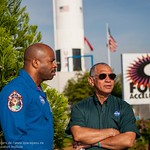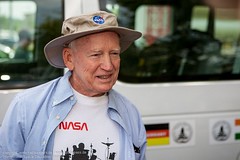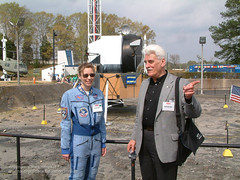| Events - Competitions |

 Registration complete! Today in Leipzig 10 students have confirmed their participation at NASA top talent competition. It was at the end again a thrilling head-to-head race. Three students withdrew their application in the last minute. They didn't felt ready for the high and demanding mission. The remaining participant formed the only competing teams from Europe (Germany and Russia). Two other teams (Italy and Russia) had to withdraw their application.
Registration complete! Today in Leipzig 10 students have confirmed their participation at NASA top talent competition. It was at the end again a thrilling head-to-head race. Three students withdrew their application in the last minute. They didn't felt ready for the high and demanding mission. The remaining participant formed the only competing teams from Europe (Germany and Russia). Two other teams (Italy and Russia) had to withdraw their application.
Other educational institutions in Luxembourg, France, Spain and England weren't able to gather a sufficiently powerful team around them, even though the International Space Education Institute organized 250 events to prepare in advance. This contest is something like the world skills for young apprentices and engineers at the highest level.From the over 1000 parts of the Moon Buggy are 60% self-designed and self-fabricated. The other parts are hand picked standard industrial parts. In Leipzig we are particularly proud of our new differential gear and the advanced telemetry.
NASA expects the teams and the candidates to produce a video presentation, a description of all members and a team photo. Here is the Teamvideo for 2013:
Huntsville Alabama, In the Marshall Space Flight Center preparations are running at full speed. It is the 20th Anniversary of NASA's top junior competition. A record number of 119 teams have applied for the 2013 competition and this year's competition is uniquely, so it may lack nothing. Astronauts have been put on the guest list, entrepreneurs and supporters are invited even government officials from Washington announced their arrival. Hundreds of volunteers are preparing in the US Space & Rocket Center. To ensure there first Priority, a secure and smooth run of the competition. The advertising departments of industrial sponsors prepare the facilities and VIP areas. The jury has been starting advising on already handed in price applications. There are many awards in many disciplines. The work is carefully studied and evaluated. The over 1000 Competitors, from 14-22 are at the forefront, they deserve all the expenditure because the future belongs to them.

 In the center are two dedicated women from the Human Resources Office of the High-tech giant “WILL Technology”. This expertise Company of Engineering is also one of the most important training grounds for leading engineers in the United Staates. Here are the best of the best selected, tested, formed and passed on to high-paying jobs. Diedra Williams and Dr. Marilyn Lewis are leading this department. They are experienced in dealing with candidates and young researchers. They form the core of the competition with the support of NASA. Both have great organizational skills and remain calm at any moment.
In the center are two dedicated women from the Human Resources Office of the High-tech giant “WILL Technology”. This expertise Company of Engineering is also one of the most important training grounds for leading engineers in the United Staates. Here are the best of the best selected, tested, formed and passed on to high-paying jobs. Diedra Williams and Dr. Marilyn Lewis are leading this department. They are experienced in dealing with candidates and young researchers. They form the core of the competition with the support of NASA. Both have great organizational skills and remain calm at any moment.
On the edge are often inconspicuous and watching spectators... It is NASA's top from Washington D.C.. Such as in 2012 when NASA administrator Charles Bolden visit the competition unexpected. Because of his judgment it was allowed to the Leipzig international teams to exhibit a moon buggy in the US Space & Rocket Center (USSRC) museum next to the original Apollo rovers. Team member Evgeniy Zakutin was shortly afterwards offered to complete his doctorate in Huntsville.
Called into the life was the NASA’s Great Moonbuggy Race by Dr. Frank Six. The NASA scientist runs the office for human capital of the Marshall Space Flight Center (whose director in the 70's was the by-choice Leipziger Eberhard Rees) and is closely connected with the University of Alabama in Huntsville (UAH). In 1993 Six called in all surviving designers of the Apollo Moon Rovers and planned the competition with them. The claim is a self-made vehicle with all the technical requirements for a trip to the moon and on its surface. Only the low-energy drive is placed, for insurance reasons on muscle strength. The muscle actuator makes out of this design competition a sports event with many emotions, movement, joy and enthusiasm. It is an experience, to see the work of multiple tinker of a vast variety of nations. There are no rivals. Everyone helps everyone - an important and given basic value which is awarded by the Jury.
The strict jury checks the fold-ability of the vehicle to a certain degree, tests the young designers and observed with 19 individual judges whether the route is run correctly and safely. Boys and Girls need to be driving the moonbuggy.
The head of the jury Dr. Konrad Dannenberg (senior engineer in the Apollo program, rocket propulsion), from 1993 to 2008, was born in Weissenfels, near Leipzig. NASA scientist Dr. Jesco von Puttkamer, who was born in Leipzig campainged for the International League with a team from Leipzig. In honor of his life's work for the young, and for the continuation of this work, are not only students flying in April 2013, but also the first time a German business delegation to the Moon Rocket City of Huntsville, Alabama, USA.
Team Germany High-school: Araceli Zeller (14), Sang Jin Kim (16), Tobias Volte (18), Tobias Meier (17), Cosma Heckel (6, guest competitor)
Team Russia College: Evgeniy Zakutin (25), Nadin Roessler (19), Alexander Frolov (24), Thommy Knabe (22), Roman Tarasov (15)
The travel programm of the team (PDF, 1MB)
the differential gear
the telemetry
translated by: Tobias Damm (17), International School Leipzig
On March 28 2013 was a meeting held at the U.S. Consulate in Leipzig with the founders of the International Space Education Institute (ISEI), Yvonne and Ralf Heckel, and the Consul for Public Affairs, Ms. Teta Moehs. The last visit between the two parties took place in 2006. It was a meeting with the former Consul Scheland, just before a shuttle launch. There was a cordial conversation about the activities of the Institute since then. The results earned respect. Despite tight time schedules, both parties agreed to stay in closer contact. Above all, the ISEI contributes to educational as well as cultural work with its 10-year experience and the support of about 70 exchange students. Furthermore, the ISEI maintains good relationships with high-tech companies in the U.S. and Germany. The Board is a member of the German-American Heritage Foundation (Washington), the Astronaut Memorial Foundation (Cape Canaveral) and a member of the Ambassador program of the U.S. Space & Rocket center in Huntsville Alabama. Multiple reciprocal visits each year consolidate these relations. Ms. Moehs reported on the current work of the consulate and handed over the book "Apollo - The story of the first voyages to the Moon" for the Institutes-library. It was made a group photo for the Facebook page of the U.S. Consulate. On the next day, the U.S. Consul Marc J. Powel and Ralf Heckel met at the German-American “Stammtisch” at the cafe Telegraph for a first getting-to-know-meeting. Facebook-Site US-Consulate Leipzig translated by: Tobias Damm (17), International School Leipzig
Today, the new differential gear of the Moon Buggy on the intec subcontracting was presented in Leipzig. The German engineering companies and Madler IGUS had accompanied the 5-year development of this transmission with material. The development was supported by an international team of students (14-18 years old), headed by a young engineer from Moscow (22) and the auspices of the "International Space Education Institute" conducted in Leipzig. Involved in the production and processing of individual parts to the CAD templates were, the Saxon company: Machine Shop Günter Jacob, Wittenbecher engineering, mechanical engineering Aischmann, Holl GmbH and 1st Mould. The development was funded by the association on its own power with the assistance of Messrs. Bruno Banani and the Space Hotel Leipzig. The 5 - year development was primarily based on the high standards required for success in the NASA Moonbuggy Race. There were 16 high performance races recorded with a variety of data sensors and data telemetry. Through the data collection we were able to significantly optimizes the transmission in three generations. There was a scientific circle between development - test results - evaluation and development. During this time, two team members completed their preparatory course with this subject in high school with top grades. At the INTEC-Subcontracting Fair in Leipzig chief designer Evgeniy Zakutin (ISEI) and the producers Ronny Hessel (turnery Günter Jakob) and Siegfried Aischmann (Aischmann engineering) presented the new Moon Buggy transmission. At the stands of Mädler and IGUS hit the freshly assembled core of successes. It was remanded to the director of the Fa IGUS, Mr. Ing Thomas White. This gearbox is part of the 6th manus ® competition for plastic plain bearing applications of the Fa. IGUS and will be presented to the public on April 10th 2013 at the Hanover Fair. The special features of the rugged and lightweight transmission include the use of maintenance-free polymer bearings, the use of reinforced carbon fiber by injection of molding and of course the young average age of the developer - 17 years. The production-ready gear is now has a variety of applications and is not just for NASA's Moonbuggy Race, but also a design competition for high-performance teams. So it is particularly suitable for light electric vehicles, electric quads, trikes, Ped-Mobile, wheelchairs and automatic guided industrial mobile equipment. It is fit to use up to a torque of 300 Nm (ca. 220 Pound-force foot). The long and difficult road to a flawless product requires all teamwork, integrity, excellence, ideas, dedication and patience. Here is a summary of annotated images with large photos of the laborious development in 5 years. All those involved have grown so beyond itself:
Application for the manus®-contest (PDF, 24 MB),
highschool student (age/participation in years): college students and young engineers: supervisors/idea/financiation/correktur: supporting people (materialdonators & help): and many other privat persons and handicraft workers, who are supporting the Moonbuggy-Project in Germany supporting industrial companies (materialdonators & help): supporting companies (money donations):
see also "Orbituary: Jesco von Puttkamer"
"The message of Professor von Puttkamers dead came to us as we prepared the next generation of students for the NASA Moonbuggy Race, only some hours after he passed away. We all were shocked about the loss of a good teacher, famous scientist, perfect visioneer, excellent engineer and a warm friend. It was Christmas, only some steps away from his house of birth, Leipzig, Saxony, Germany. “The Professor” was and is an idol for our young generation from Germany, Russia, India, Italy, France and Huntsville. His stories, his power and his hints made a deep echo into the visions of these kids. He was a man from the far – so close to everybody who had the chance to meet him. “Prof. Dr. von Puttkamer” was an institution for the human spaceflight for all people who worked and lived in the space family at NASA, ESA, DLR and Roscosmos. He was the one from the last. A workaholic anytime, a man who was able to crab the future like a body and who had the history in his pockets. A man who had an opinion with a large fundament and an autopilot in his head. This machine was programmed for the future. Unfortunaly on the place of the ISS-status reports is a hole now, a hole in the brain of each space scientist, engineer and enthusiast. “Jesco” was a call what was used by not many people in this world. To be a friend of this legacy was a honor and a large responsibility. This name was a bridge between the Korolevs and the von Brauns, between the rocketeers and the greenhorns, between the experts and the idealists. Jesco was a friend and a racehorse for people who were big enough to follow his ideas. Uncounted times we were able to sit with him together on the carpet in his house on the Monte Sano in Huntsville were he lived in the Apollo Era, in the Salineos Subvilla were he got his subs for the NBL-work in the time of spacelab, in the El Palacio were the von Braun Team drank a beer after work and in the grass under the oaks next to the von Braun cementary in Ivy Hill in Alexandia were he was near the tears. Anytime he told us incredible stories from the past and his logic result for the future. We had the luck to know the Professor, the engineer and the friend very well since 15 years. This time was an awesome honor for us. He opened doors for our students and us to the NASA-Centers KSC, MAF, Michoud AF, JSC, MSFC, USSRC and ignited the international division of the NASA Moonbuggy Race in 2007. We were able to see 3 Space Shuttle launches, rocket launches, spoke with the ISS-Crew 6 and were able to carry more than 100 international students to the NASA holy halls of the future. 100 times more students are reading our reports with a gleaming heart. His words “I hang my head far out of the window here – don’t let me hang there” – was law for us as teacher and for our students. Never we or they let him hang. We were able to open doors to the Korolev Family (Sputnik Designer), to a vision of an idealistic young generation and to the Russian holy halls of spaceflight. Unforgettable are the words of him. There will be never forgotten and are the spirit, the fuel for a future and a generation of exploration: But mostly we have respect for this words: Jesco von Puttkamer was the strategic thinker the architect of our International Space Education Institute in Leipzig. Since 10 years we were able to give his ideas of space education a realistic house in his town of birth, a center between his old home, the new and other world. Today it is an independend non-profit association with 250 extravagant high-performance activities per year. We are proud about a bridge of education, exchange and excursions between Huntsville, Leipzig and Korolev-City. We are teaching students to build high performance teams and teach them to find goals of those projects at the space competitions in this world. Hundreds of sponsors, donators and scientists are now behind this. First start up companies of engineering and space tourism are producing their first win and …. of course taxes. Yestarday, on the February 3rd of 2013 we had a general meeting. We were discuss how we can honor for Prof. von Puttkamers work so, that space students will have anytime a win from it. We choose to found the “Jesco von Puttkamer Foundation”. Countless artifacts and a provision of the win of all of our startup-companies will form the basics of this corporate citizenship. The opening ceremony will be on his 80th birthday, the September the 22th 2013 in Leipzig. A group of international space scientists will select the best international students who made good results in space business in more than 3 countries. They will receive cash prizes and educational support for their future. May this be a bridge into the future of all of us – in memory of Prof. Dr. Jesco von Puttkamer. We invite all interested people to be a part of this foundation and its jury. The Mars and the extraterrestical evolution was his logic dream for the future – now we have the responsibility to do it. Yvonne and Ralf Heckel
The days in mid-February 2013 will burn into the global memory. After initial reports of the Chelyabinsk-Meteor arrived on Friday afternoon, it was clear that this is a natural phenomenon that will not be forgotten quickly. In the evening, took the DA14 Asterioid its flyby to the Earth and moved silently across the cloudy night sky. Like as a "Good Bye" a small meteorite throughed the sky over Leipzig. from Ralf Heckel Humanity woke up from a sleep as a blinding flash of light and thunderous bang rolled over the Russian city of Chelyabinsk on the afternoon of 14 February 2013. It was a meteor of about 10 tons, only a few ft´s tall and could not be detected in advance. He damaged by the shock wave to a loss of about 250 million euros. According to media disclosures about 1200 people have been injured by broken glass. Many motorists and people stopped this event firmly on their dashboard- and mobile phone cameras. After a few hours, dozens very good records were in the Internet, which are all unique. It is spoken by an explosion that triggered seismic sensors around the globe. Anyone who has experienced the re-entry of a space shuttle, who knows that there is a loud double bang from the sound barrier breakdown. The speed of sound becomes slowler in colder, higher altitude atmosphere. Is there a re-entry of a body by fast speed, it will become a critical level by a lower altitute, which is built up the sound barrier. It still takes place in areas around Mach 10-20 and at altitudes of 30-50 km. The "Bang" is not from an explosion, like all medias explained. This "Super Sonic Boom" went out to the higher atmosphere, Only a small amount of energy penetrating the lower layers of air with a lot of echoes and at different speeds. It was still large enough to let go thousands windows and doors to break and is compared with the energy of 20 times of a Hiroshima bomb. Fortunately, distributed the bang and the shock wave through the high speed projectile on an elongated period. If the boom would all arrived at once, then the damage would be more. "From now on the people on the earth begins a new awareness of cosmic events - which also has its good points." During this time, the amateur astronomer Henri Schulz worked in the north of Leipzig, still at his observatory (www.sternwarte-kletzen.de). He would like to take the announced for the evening flyby of Asterioiden DA14 and feeds the computer with fresh data from Hamburg. This proves to be very difficult because no observatories software can calculate a swingby maneuver. In one maneuver the swingby Asterioid is deflected by the gravity of the earth, and changes its flight path. He pulls a slight curve near the Earth and continues to fly in a different direction. The Science uses this for unmanned spacecrafts to accelerate their long trajectories in Jupiter- or Saturn system or even control. Rush Mr Schulz programmed and selected some windows. But the serene afternoon sky over Leipzig plays not with him, it runs on the evening. At least now all astronomers went into the warm house and watching the events in the Internet. Out of sheer anger at the many useless programming work and the cloud-covered sky Mr. Schulz pushes yet in his observatory Kletzen the B´button. ...and to the surprise of all, he recorded the path of DA14 over Saxony, by cloudly sky! 24 hours later, still on the Internet only recordings from Australia can be found, but not from Germany. Although the image quality of Asterioiden snapshot is through the clouds is not particularly good, but you can clearly see the 5-minute track of DA14. To the surprise of even a small meteorite suggests itself in the image. How small is the observed part of the sky, can be seen in photo 2. The small gray rectangle in the red trace is precalculated about the size of the captured photos represent a sufficiently precise calculation of the trajectory of the meteorite after its swingby maneuver. It is a major accomplishment. A connection between the DA14 and Chelyabinsk-Meteor on the same day there is not. But there is a correlation between the randomly picked micro meteorite Leipzig and Chelyabinsk meteor. Both came from the same direction. More on www.sternwarte-kletzen.de |
















































































































